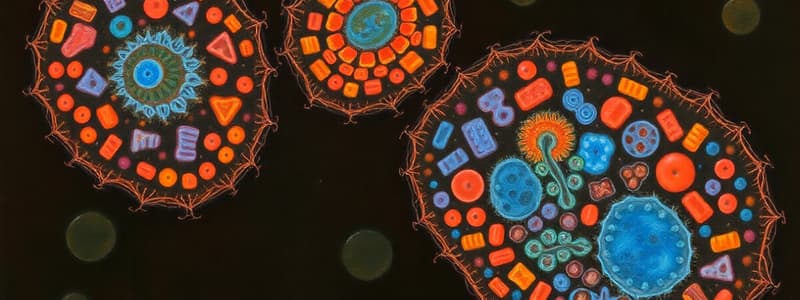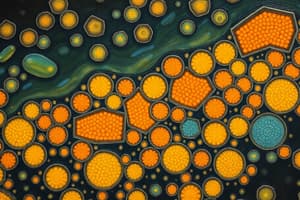Podcast
Questions and Answers
What is the role of transport vesicles in eukaryotic cells?
What is the role of transport vesicles in eukaryotic cells?
- They transport molecules only between the nucleus and the cytoplasm.
- They serve as storage units for cellular waste.
- They allow communication between topologically equivalent compartments. (correct)
- They synthesize cargo molecules within organelles.
Which organelles are excluded from the vesicular traffic described?
Which organelles are excluded from the vesicular traffic described?
- Endoplasmic reticulum and Golgi apparatus
- Secretory vesicles and nuclear envelope
- Lysosomes and endosomes
- Mitochondria and plastids in plant cells (correct)
What does the term 'topologically equivalent compartments' refer to?
What does the term 'topologically equivalent compartments' refer to?
- Compartments that are connected through membrane budding and fusion. (correct)
- Compartments that have the same physical structure.
- Compartments that only interact with the cell's outer membrane.
- Compartments that perform identical functions within the cell.
What role does the nuclear envelope play in vesicular transport?
What role does the nuclear envelope play in vesicular transport?
How do cycles of membrane budding and fusion affect organelles?
How do cycles of membrane budding and fusion affect organelles?
What does the nucleolus exemplify in cellular biology?
What does the nucleolus exemplify in cellular biology?
What is the ratio of the endoplasmic reticulum's membrane surface area in liver cells compared to the plasma membrane?
What is the ratio of the endoplasmic reticulum's membrane surface area in liver cells compared to the plasma membrane?
The first eukaryotic cells likely arose from a symbiotic relationship between which two types of cells?
The first eukaryotic cells likely arose from a symbiotic relationship between which two types of cells?
What structure in ancient archaeons might have stabilized the highly curved membranes during cell migrations?
What structure in ancient archaeons might have stabilized the highly curved membranes during cell migrations?
What facilitated metabolite exchange for early eukaryotic cells?
What facilitated metabolite exchange for early eukaryotic cells?
What are the topologically equivalent compartments explained in the context of the eukaryotic cell's evolution?
What are the topologically equivalent compartments explained in the context of the eukaryotic cell's evolution?
During the evolution of eukaryotic cells, what happened to the internal compartments that were formed?
During the evolution of eukaryotic cells, what happened to the internal compartments that were formed?
What event marked the early development of modern mitochondria from a symbiotic relationship?
What event marked the early development of modern mitochondria from a symbiotic relationship?
What is the primary function of transport vesicles in eukaryotic cells?
What is the primary function of transport vesicles in eukaryotic cells?
Which of the following statements about membrane budding and fusion in eukaryotic cells is accurate?
Which of the following statements about membrane budding and fusion in eukaryotic cells is accurate?
What is NOT a characteristic of topologically equivalent compartments in a eukaryotic cell?
What is NOT a characteristic of topologically equivalent compartments in a eukaryotic cell?
Which organelles are generally excluded from the vesicular traffic described in the context of eukaryotic cells?
Which organelles are generally excluded from the vesicular traffic described in the context of eukaryotic cells?
What role do the blue arrows in the depicted diagram serve?
What role do the blue arrows in the depicted diagram serve?
Which statement about the endoplasmic reticulum in liver and pancreatic cells is accurate?
Which statement about the endoplasmic reticulum in liver and pancreatic cells is accurate?
What did the protrusions on the membranes of early eukaryotic cells likely facilitate?
What did the protrusions on the membranes of early eukaryotic cells likely facilitate?
How did the first eukaryotic cells utilize the symbiotic relationship with an aerobic bacterium?
How did the first eukaryotic cells utilize the symbiotic relationship with an aerobic bacterium?
What does the lumen of internal compartments in eukaryotic cells represent?
What does the lumen of internal compartments in eukaryotic cells represent?
Which aspect of early eukaryotic cells made them resemble modern-day eukaryotes?
Which aspect of early eukaryotic cells made them resemble modern-day eukaryotes?
What is a likely result of the internal compartments expanding in an early eukaryotic cell?
What is a likely result of the internal compartments expanding in an early eukaryotic cell?
What characterized the migration of the early eukaryotic cells?
What characterized the migration of the early eukaryotic cells?
Why can the cytosol and nucleus of an ancient archaeon intermix during mitosis?
Why can the cytosol and nucleus of an ancient archaeon intermix during mitosis?
Flashcards
Nucleolus structure
Nucleolus structure
The nucleolus is a non-membrane-bound structure within the nucleus, a type of biomolecular condensate.
ER membrane surface (liver/pancreas)
ER membrane surface (liver/pancreas)
The endoplasmic reticulum (ER) membrane surface area is significantly larger than the plasma membrane's area in liver and pancreatic cells.
Eukaryotic cell origin
Eukaryotic cell origin
Eukaryotic cells evolved from the union of an anaerobic archaeon and aerobic bacterium.
Cell protrusions role
Cell protrusions role
Signup and view all the flashcards
Nuclear pore formation
Nuclear pore formation
Signup and view all the flashcards
Mitochondria origin
Mitochondria origin
Signup and view all the flashcards
Intracellular compartments' relation
Intracellular compartments' relation
Signup and view all the flashcards
Nucleus vs. Cytosol
Nucleus vs. Cytosol
Signup and view all the flashcards
Transport Vesicle
Transport Vesicle
Signup and view all the flashcards
Topologically Equivalent Compartments
Topologically Equivalent Compartments
Signup and view all the flashcards
Secretory Pathway
Secretory Pathway
Signup and view all the flashcards
Endocytic Pathway
Endocytic Pathway
Signup and view all the flashcards
Vesicular Trafficking
Vesicular Trafficking
Signup and view all the flashcards
What is a biomolecular condensate?
What is a biomolecular condensate?
Signup and view all the flashcards
Plasma membrane vs. ER membrane
Plasma membrane vs. ER membrane
Signup and view all the flashcards
Eukaryote origin
Eukaryote origin
Signup and view all the flashcards
Protrusion function
Protrusion function
Signup and view all the flashcards
Vesicular transport
Vesicular transport
Signup and view all the flashcards
Nucleus-Cytosol relationship
Nucleus-Cytosol relationship
Signup and view all the flashcards
Study Notes
Intracellular Organization and Protein Sorting
- Macromolecules and their associated activities are spatially separated within cells.
- Eukaryotic cells are subdivided into membrane-enclosed compartments (organelles).
- Examples of organelles include the endoplasmic reticulum, Golgi apparatus, lysosomes, plastids, and mitochondria. These are sometimes further divided by internal membranes.
- Biomolecular condensates are dynamic assemblies of macromolecules. They can specialize as factories or storage centers.
- The nucleolus is a biomolecular condensate not enclosed by a membrane.
- Animal cells have about 10 billion protein molecules of about 10,000 kinds.
- Protein synthesis starts in the cytosol (outside the membrane-enclosed organelles).
- Proteins are specifically delivered to the organelles that need them.
- Organelle surfaces have unique protein and lipid compositions used to target protein and lipid deliveries.
- Eukaryotic cells have the same basic set of membrane-enclosed organelles.
- These compartments increase biochemical reaction areas and functionally specialize different spaces inside cells.
- Compartments allow reactions requiring different conditions to occur simultaneously, without interfering.
- Specific organelles exist for specific biochemical functions. Rough and smooth ER, Golgi, lysosomes, mitochondria, endosomes, and peroxisomes.
Relative Volumes of Intracellular Compartments
- In a liver cell, cytosol occupies about 54% of the total cell volume.
- Other major intracellular compartment volumes include: mitochondria (22%), rough ER (9%), smooth ER (5%), Golgi (6%), nucleus (1%), peroxisomes (1%), lysosomes (1%), and endosomes (1%).
Relative Membrane Types
- In liver cells, the plasma membrane makes up a small percentage (2%) of the total membrane surface.
- The rough endoplasmic reticulum accounts for a large percentage (35%), followed by the smooth ER (16%) and Golgi (7%).
- Mitochondria (7%) and other membrane systems have smaller percentages.
Evolutionary Origins of Organelles
- Eukaryotic cells possibly originated from the joining of an anaerobic archaeon and an aerobic bacterium.
- Cell migration may have played a crucial role in this process.
- Protrusions likely stabilized internal membranes.
- The symbiotic relationship with an aerobic bacterium likely enabled the archaeon to increase in size.
- These protrusions may have fused ultimately leading to internal membranes, primordial nucleus, and an endosymbiont.
Topological Relationships of Organelles
- The lumen of internal compartments in eukaryotes is topologically equivalent to extracellular space.
- Endosymbiosis lead to mitochondria.
- Internal compartments progressively specialized into organelles.
- Organelles can exchange materials/information through vesicular transport.
Topologically Equivalent Compartments
- Molecules can move between topologically equivalent compartments via transport vesicles.
- The transfer permits communication among compartments.
Intracellular Compartments in Eukaryotic Cells
- The major compartments are categorized into three groups: nucleus & cytosol, secretory/endocytic pathways, and endosymbiotic organelles (e.g., mitochondria, plastids).
Macromolecules Segregation
- Macromolecules can selectively segregate without a surrounding membrane.
- Scaffolds (nucleic acids or proteins) create condensates.
- Clients are specific molecules attracted to the scaffold via weak binding interactions.
- Concentration of components helps them function in that local region.
Biomolecular Condensates
- These are diverse, with different roles. Examples include nucleolus, pyrenoids, stress granules, P-granules, and others.
Biomolecular Condensates and Factories
- Condensates can act as biochemical factories. The pyrenoid example concentrates proteins involved in carbon fixation.
Biomolecular Condensate Response to Needs
- Formation and stability depend on weak interactions that overcome entropy.
- Small changes can alter formation, and physical properties.
- Need-based activation or deactivation of signaling components can lead to condensation or disassembly.
Studying That Suits You
Use AI to generate personalized quizzes and flashcards to suit your learning preferences.




